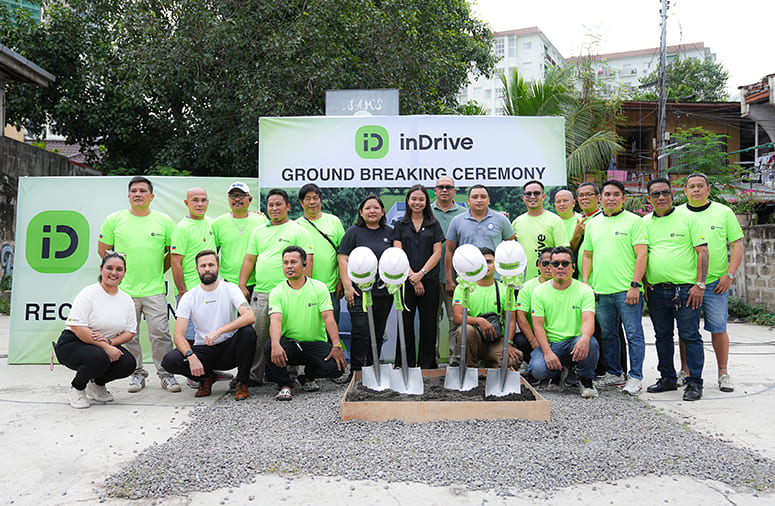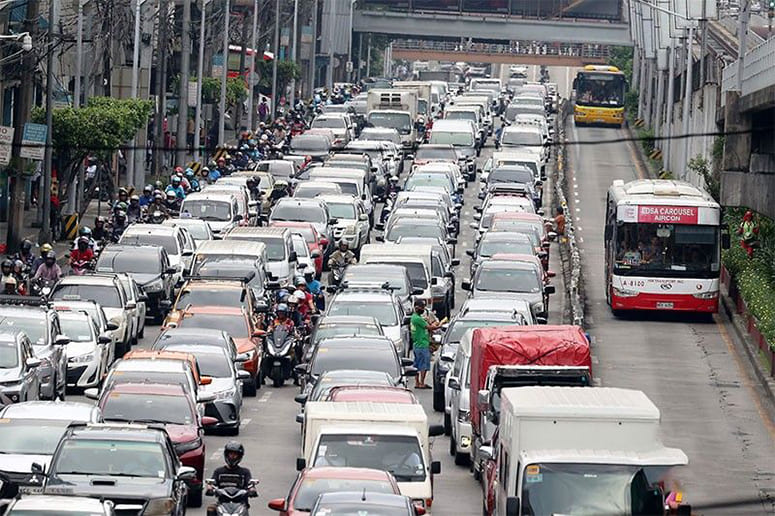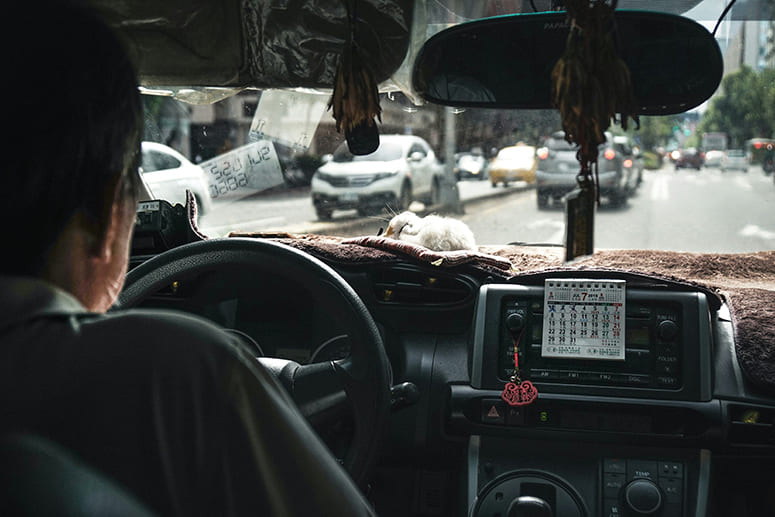inDrive is reimagining vehicle and commuter movement in EDSA (and beyond)
In 2018, a woman gave birth while stuck in the EDSA traffic jam.
But this isn’t the only unhinged story involving the infamous major road. Some are shared in personal spaces, when an employee apologizes for coming in late despite waking up early, or a friend complains about their three-hour travel time on a Friday night out. With the Epifanio de los Santos Avenue covering six cities in Metro Manila, Filipinos are tethered to it despite the inconvenience.
While it’s been a running gag that people can age up while in EDSA’s sea of rush hour red lights, this collective experience reflects citizens’ deteriorating quality of life. As a matter of fact, over 400,000 vehicles travel through the thoroughfare when it can only hold up to approximately 300,000, according to the Metro Manila Development Authority.
Apart from overcapacity, criticisms that surround the quintessential EDSA experience include a lack of proper commuter-friendly infrastructure and poor traffic management, among others. So when the EDSA rehabilitation program was unveiled, motorists and commuters wondered if this would end their suffering.
John Louie Balagot, country public policy and government affairs manager of inDrive Philippines, is one of those hopeful it will pave the way for “real transformation”—and this means not leaving commuters behind.
“We must ask questions like: How will this affect the number of rides that a TNVS driver or a delivery rider can complete every day? Or how much will this affect the expenditure of a minimum wage earner who, instead of riding just one bus going to work, now has to make two to three cutting trips? This can’t just be a roadworks project—it must be a mobility rethink,” he tells The Philippine STAR.

Balagot adds, “If we want real impact, we must ask: Are we designing for movement or just for vehicles? A genuine reset should build toward an inclusive, multimodal future (which includes) safe, accessible pedestrian crossings and protected bike lanes; designated zones for TNVS, PUVs, and other alternative modes; stronger integration across trains, buses, and shared mobility platforms; and real-time, commuter-informed planning, not just traffic simulations.”
Originally slated to start on June 13 this year, the project was recently proposed by the Department of Public Works and Highways to be moved to 2026 given the rainy season’s onset; President Marcos Jr. also called to explore “better” technologies.
Reimagining the EDSA Rehabilitation Program
Being hopeful, of course, can come with scrutiny. After all, fixing EDSA would mean continuous adjustment until it wraps up in 2027.

One of people’s worries is the shared lane for bicycle and motorcycle riders. Balagot says, “Bicycles and motorcycles may both be two-wheeled, but they are vastly different in terms of speed, vulnerability, and safety requirements. Forcing both into a single lane risks increasing collisions and deterring active transport altogether. If we want to encourage cycling, dedicated and protected bike lanes are non-negotiable.”
Balagot shares that inDrive plans to go about the program through real-time operational support through in-app tools:
- Upgraded route optimization features that adapt dynamically to rerouting schemes and traffic advisories.
- Targeted push notifications alerting users to MMDA directives, coding changes, and unplanned road closures.
- Context-aware driver alerts identifying affected zones, congestion hotspots, and high-demand areas to guide efficient and informed driving decisions.
They also aim for user empowerment, plus policy collaboration with government agencies (like the DOTr and the Land Transportation Franchising and Regulatory Board) and other stakeholders to:
- Relay real-time feedback from drivers to identify gaps in implementation and suggest practical, data-driven adjustments.
- Share anonymized data insights on trip patterns, peak-hour demand, and friction points to inform transport planning.
- Advocate for inter-agency coordination, ensuring that regulatory measures are coherent, consistent, and supportive of the commuting public.
Balagot adds, “We also emphasize the importance of complementary commuter solutions—including expanded bus capacity, improved MRT reliability, and safer, more accessible pedestrian infrastructure.”

“We want reforms to happen with the community—not to them. By combining technological innovation, grassroots feedback, and institutional collaboration, inDrive is committed to helping Metro Manila transition smoothly, sustainably, and equitably.”
What makes up commuter-first infrastructure?
As ordered by President Marcos Jr., the DOTr is dismantling “Mt. Kamuning,” the nine-meter footbridge spanning EDSA in Quezon City. It resurfaces every now and then as a laughing stock online, with Filipinos criticizing its steepness, making it difficult for people to move, especially senior citizens and persons with disabilities.
When it comes to infrastructure, Balagot describes a commuter-first approach as “seamless intermodal connections—between jeepneys, buses, trains, TNVS, bikes, and more—to reduce trip fragmentation.”
This covers safe and accessible pathways and waiting areas for vulnerable groups, plus real-time information tools for efficiency in case of uncertainty.
If we want real impact, we must ask: Are we designing for movement or just for vehicles? A genuine reset should build toward an inclusive, multimodal future.
“It’s not just about easing traffic or expanding capacity. It’s about understanding how gaps in planning affect lives,” Balagot explains. “Picture a small vendor whose usual jeepney ride is now a multi-leg journey due to rerouted roads, each transfer adding both cost and fatigue. Or a night-shift worker walking along dark, uneven sidewalks between stops. These aren’t edge cases; they’re daily realities for millions.”
Recently, inDrive linked up with the Parañaque Integrated Terminal Exchange. An inDrive booth was installed at the transportation hub’s taxi bay. As part of the Ligtas Biyahe campaign, the collaboration also includes app navigation, driver onboarding, and safety orientation sessions.
Supporting TNVS drivers’ livelihood
A 2022 Fairwork Philippines study reveals there are around 500,000 Filipinos in the gig economy’s ride-hailing, courier, and food delivery sectors. These days, it’s not surprising to encounter TNVS drivers who sell products on the side, like snacks and drinks. Support is more vital than ever, especially as the EDSA fixes will affect workers who frequent the road. “Longer trips, fuel-heavy detours, and fewer bookings can quickly reduce earnings and raise daily costs,” Balagot says.

“We promote multi-homing, uphold flexibility, and practice fairness. We don’t require exclusivity: Drivers are free to use other platforms to maximize income, especially during high-disruption periods,” he says.
In January, the ride-hailing company announced its collaboration with Coins.ph and Hivemapper to provide another source of employee income. Through a dashcam device, drivers can earn from collecting mapping data.
A genuine dialogue
“Despite being at the heart of the transport system, TNVS drivers and commuters remain largely underrepresented in urban planning. Government consultations with these groups tend to be infrequent,
reactive, and focused more on compliance than genuine collaboration. The result is often a disconnect between policy intent and on-the-ground realities,” Balagot explains.
“At inDrive, we believe meaningful reform begins with meaningful participation. A driver navigating Metro Manila’s streets daily or a commuter juggling multiple modes of transport brings insights no top-down directive can replicate. If these voices are not actively included, we risk designing systems that work on paper but fall short in practice.”
According to Balagot, these key actions would allow for TNVS drivers’ meaningful participation:
First, establish recurring forums where TNVS drivers and commuters are treated as co-creators of policy, not just recipients. These could include community transport councils, digital town halls, or government-partnered feedback sessions embedded into the planning cycle, not just during crises or major project rollouts.
Second, ground-test policies before full implementation. Testing in small zones while collecting feedback from drivers and passengers can surface practical issues early and lead to more adaptive, workable solutions.
Despite being at the heart of the transport system, TNVS drivers and commuters remain largely underrepresented in urban planning.
Lastly, make participation scalable and accessible. Traditional public hearings are limited in reach. By leveraging tech platforms like inDrive, agencies can distribute surveys, policy updates, and feedback tools directly through apps. These tools democratize input and ensure that participation isn't reserved only for those with the time or resources to attend formal meetings.
Although inDrive operates in 48 countries, Balagot says their Philippine operations work to tailor-fit to citizens’ needs, with a fairness—and flexibility-focused ethos.
“Here, commuting isn’t just a matter of distance. Delays can mean lost income or time away from loved ones. For TNVS drivers, each trip is more than a job; it’s a means of survival and support for their families.”


